Critical Analysis of Decision Making Concepts in Management
VerifiedAdded on 2022/10/06
|10
|2089
|17
Essay
AI Summary
This essay critically examines the application of decision-making principles in a managerial context, drawing upon Simon's quote on the limitations of human rationality. The paper delves into three discrete concepts: bounded rationality, rational behavior, and rationality with maximization, analyzing their theoretical underpinnings and implications for decision-making processes. It explores how bounded rationality, as proposed by Hebert Simon, impacts decision-making due to limitations in information availability and processing capabilities. The essay further investigates rational behavior and its role in decision-making, highlighting how individuals often seek optimal utility, and it discusses the concept of rationality in relation to production functions and profit maximization, emphasizing the importance of consistency and transitivity in choices. The discussion also explores the links between these concepts and their effects on the individual and organizational decision-making and the economic forces that have impacted them. The essay concludes by synthesizing the core ideas and emphasizing the significance of these concepts in understanding and improving decision-making in various situations.
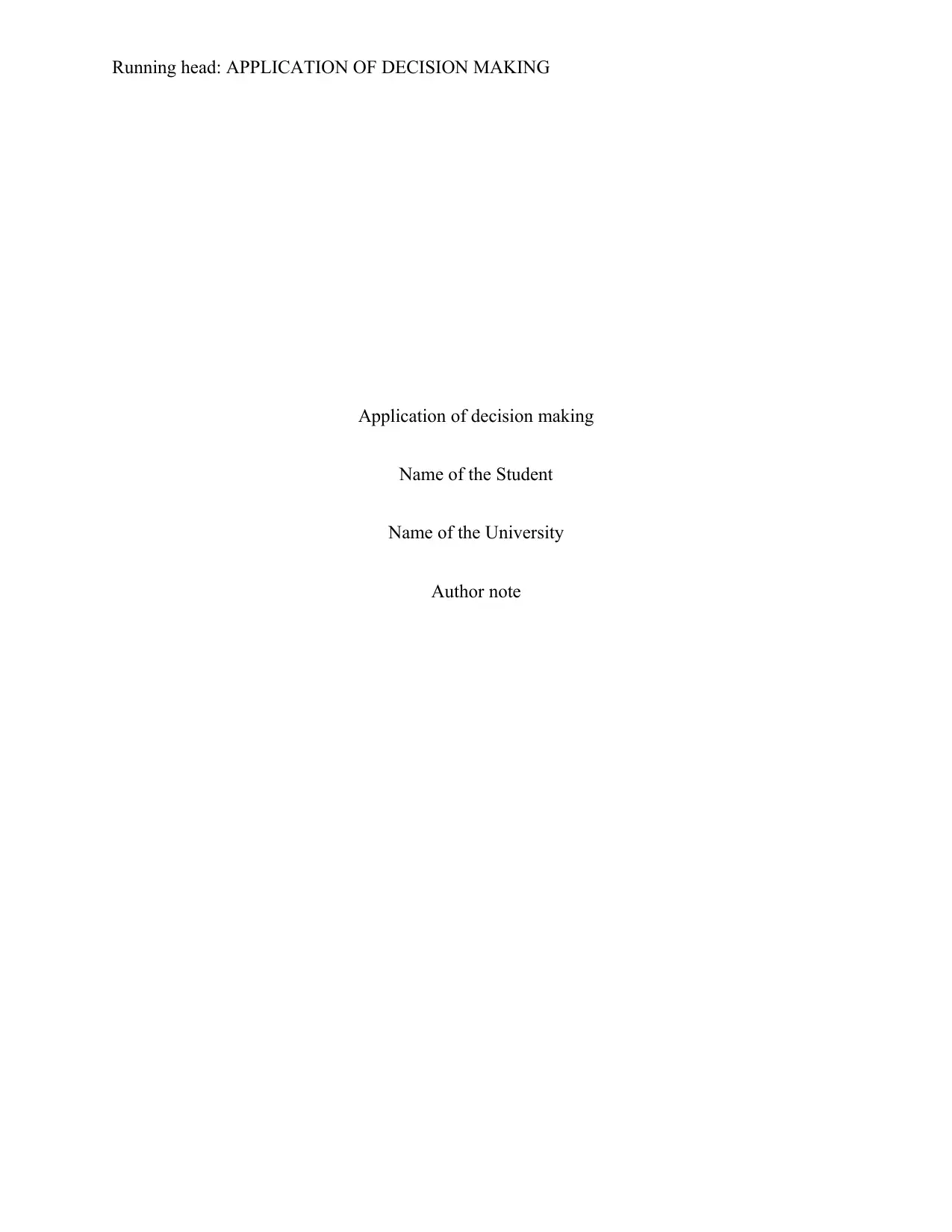
Running head: APPLICATION OF DECISION MAKING
Application of decision making
Name of the Student
Name of the University
Author note
Application of decision making
Name of the Student
Name of the University
Author note
Paraphrase This Document
Need a fresh take? Get an instant paraphrase of this document with our AI Paraphraser
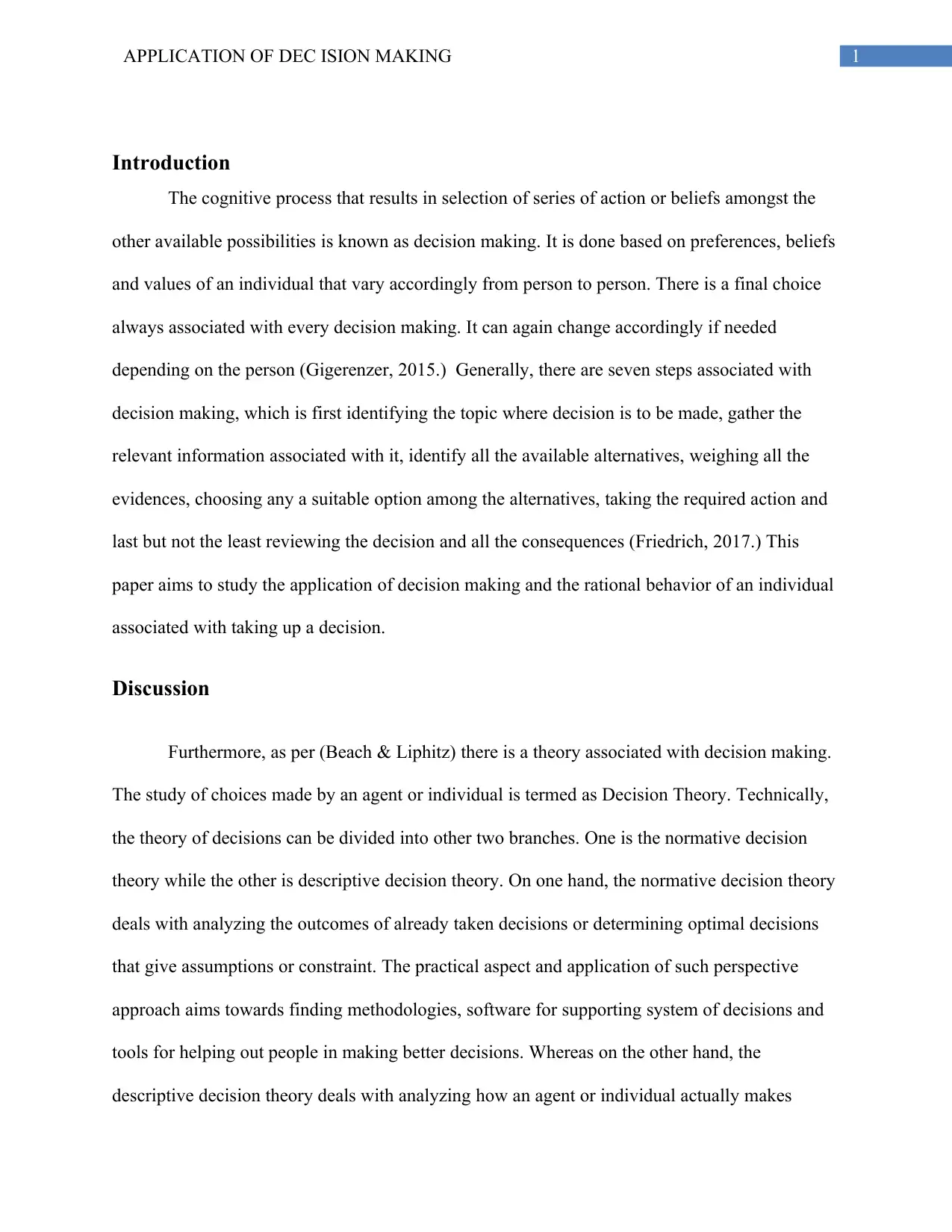
1APPLICATION OF DEC ISION MAKING
Introduction
The cognitive process that results in selection of series of action or beliefs amongst the
other available possibilities is known as decision making. It is done based on preferences, beliefs
and values of an individual that vary accordingly from person to person. There is a final choice
always associated with every decision making. It can again change accordingly if needed
depending on the person (Gigerenzer, 2015.) Generally, there are seven steps associated with
decision making, which is first identifying the topic where decision is to be made, gather the
relevant information associated with it, identify all the available alternatives, weighing all the
evidences, choosing any a suitable option among the alternatives, taking the required action and
last but not the least reviewing the decision and all the consequences (Friedrich, 2017.) This
paper aims to study the application of decision making and the rational behavior of an individual
associated with taking up a decision.
Discussion
Furthermore, as per (Beach & Liphitz) there is a theory associated with decision making.
The study of choices made by an agent or individual is termed as Decision Theory. Technically,
the theory of decisions can be divided into other two branches. One is the normative decision
theory while the other is descriptive decision theory. On one hand, the normative decision theory
deals with analyzing the outcomes of already taken decisions or determining optimal decisions
that give assumptions or constraint. The practical aspect and application of such perspective
approach aims towards finding methodologies, software for supporting system of decisions and
tools for helping out people in making better decisions. Whereas on the other hand, the
descriptive decision theory deals with analyzing how an agent or individual actually makes
Introduction
The cognitive process that results in selection of series of action or beliefs amongst the
other available possibilities is known as decision making. It is done based on preferences, beliefs
and values of an individual that vary accordingly from person to person. There is a final choice
always associated with every decision making. It can again change accordingly if needed
depending on the person (Gigerenzer, 2015.) Generally, there are seven steps associated with
decision making, which is first identifying the topic where decision is to be made, gather the
relevant information associated with it, identify all the available alternatives, weighing all the
evidences, choosing any a suitable option among the alternatives, taking the required action and
last but not the least reviewing the decision and all the consequences (Friedrich, 2017.) This
paper aims to study the application of decision making and the rational behavior of an individual
associated with taking up a decision.
Discussion
Furthermore, as per (Beach & Liphitz) there is a theory associated with decision making.
The study of choices made by an agent or individual is termed as Decision Theory. Technically,
the theory of decisions can be divided into other two branches. One is the normative decision
theory while the other is descriptive decision theory. On one hand, the normative decision theory
deals with analyzing the outcomes of already taken decisions or determining optimal decisions
that give assumptions or constraint. The practical aspect and application of such perspective
approach aims towards finding methodologies, software for supporting system of decisions and
tools for helping out people in making better decisions. Whereas on the other hand, the
descriptive decision theory deals with analyzing how an agent or individual actually makes
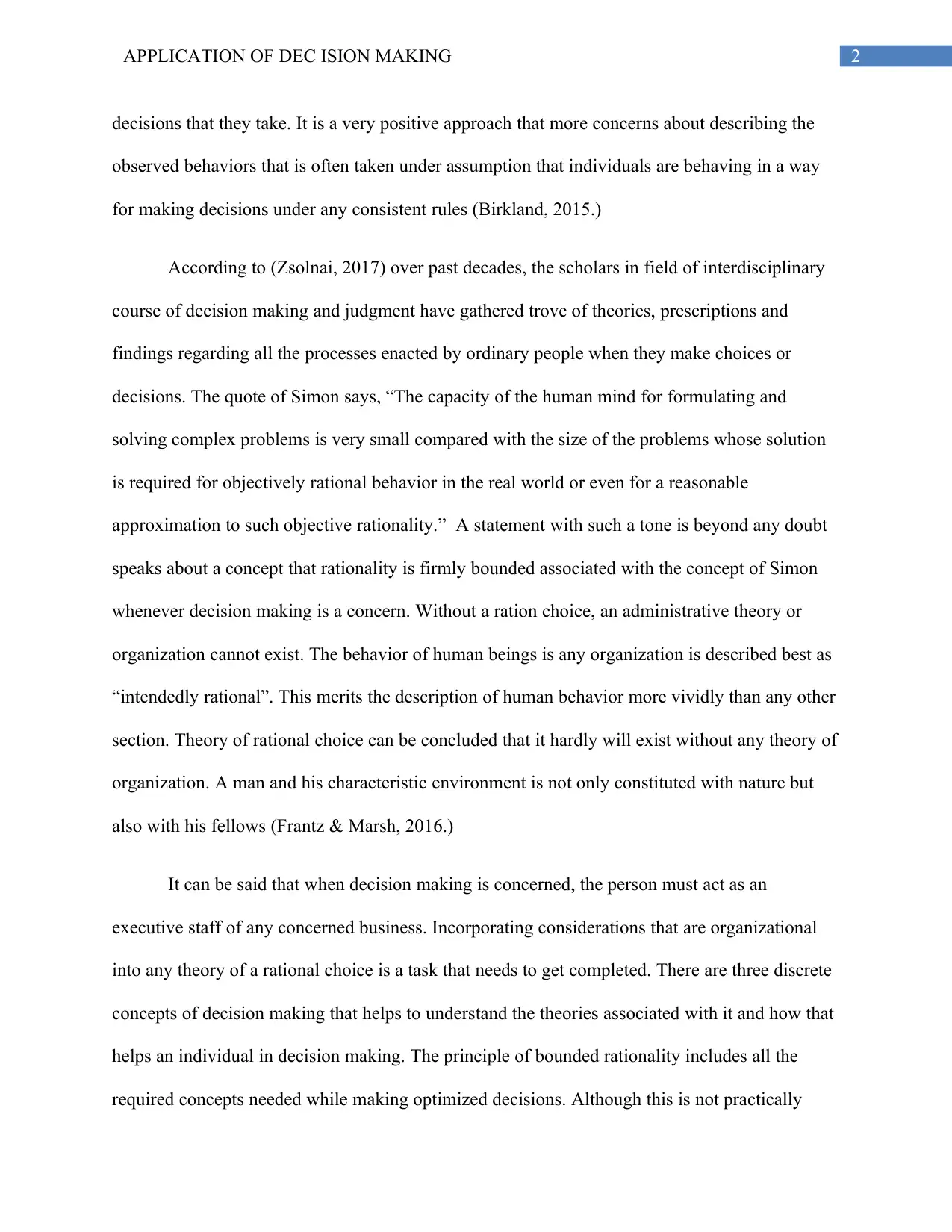
2APPLICATION OF DEC ISION MAKING
decisions that they take. It is a very positive approach that more concerns about describing the
observed behaviors that is often taken under assumption that individuals are behaving in a way
for making decisions under any consistent rules (Birkland, 2015.)
According to (Zsolnai, 2017) over past decades, the scholars in field of interdisciplinary
course of decision making and judgment have gathered trove of theories, prescriptions and
findings regarding all the processes enacted by ordinary people when they make choices or
decisions. The quote of Simon says, “The capacity of the human mind for formulating and
solving complex problems is very small compared with the size of the problems whose solution
is required for objectively rational behavior in the real world or even for a reasonable
approximation to such objective rationality.” A statement with such a tone is beyond any doubt
speaks about a concept that rationality is firmly bounded associated with the concept of Simon
whenever decision making is a concern. Without a ration choice, an administrative theory or
organization cannot exist. The behavior of human beings is any organization is described best as
“intendedly rational”. This merits the description of human behavior more vividly than any other
section. Theory of rational choice can be concluded that it hardly will exist without any theory of
organization. A man and his characteristic environment is not only constituted with nature but
also with his fellows (Frantz & Marsh, 2016.)
It can be said that when decision making is concerned, the person must act as an
executive staff of any concerned business. Incorporating considerations that are organizational
into any theory of a rational choice is a task that needs to get completed. There are three discrete
concepts of decision making that helps to understand the theories associated with it and how that
helps an individual in decision making. The principle of bounded rationality includes all the
required concepts needed while making optimized decisions. Although this is not practically
decisions that they take. It is a very positive approach that more concerns about describing the
observed behaviors that is often taken under assumption that individuals are behaving in a way
for making decisions under any consistent rules (Birkland, 2015.)
According to (Zsolnai, 2017) over past decades, the scholars in field of interdisciplinary
course of decision making and judgment have gathered trove of theories, prescriptions and
findings regarding all the processes enacted by ordinary people when they make choices or
decisions. The quote of Simon says, “The capacity of the human mind for formulating and
solving complex problems is very small compared with the size of the problems whose solution
is required for objectively rational behavior in the real world or even for a reasonable
approximation to such objective rationality.” A statement with such a tone is beyond any doubt
speaks about a concept that rationality is firmly bounded associated with the concept of Simon
whenever decision making is a concern. Without a ration choice, an administrative theory or
organization cannot exist. The behavior of human beings is any organization is described best as
“intendedly rational”. This merits the description of human behavior more vividly than any other
section. Theory of rational choice can be concluded that it hardly will exist without any theory of
organization. A man and his characteristic environment is not only constituted with nature but
also with his fellows (Frantz & Marsh, 2016.)
It can be said that when decision making is concerned, the person must act as an
executive staff of any concerned business. Incorporating considerations that are organizational
into any theory of a rational choice is a task that needs to get completed. There are three discrete
concepts of decision making that helps to understand the theories associated with it and how that
helps an individual in decision making. The principle of bounded rationality includes all the
required concepts needed while making optimized decisions. Although this is not practically
⊘ This is a preview!⊘
Do you want full access?
Subscribe today to unlock all pages.

Trusted by 1+ million students worldwide
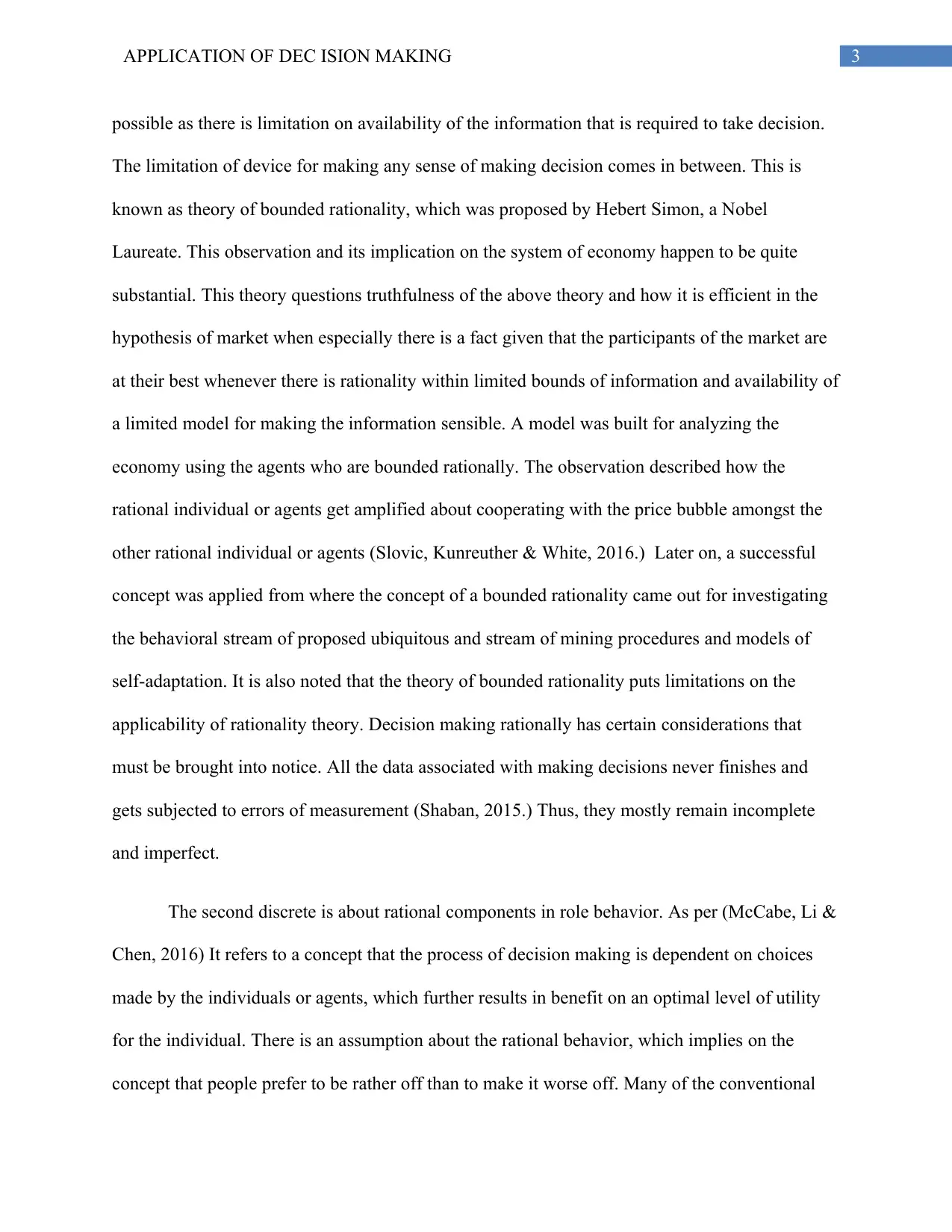
3APPLICATION OF DEC ISION MAKING
possible as there is limitation on availability of the information that is required to take decision.
The limitation of device for making any sense of making decision comes in between. This is
known as theory of bounded rationality, which was proposed by Hebert Simon, a Nobel
Laureate. This observation and its implication on the system of economy happen to be quite
substantial. This theory questions truthfulness of the above theory and how it is efficient in the
hypothesis of market when especially there is a fact given that the participants of the market are
at their best whenever there is rationality within limited bounds of information and availability of
a limited model for making the information sensible. A model was built for analyzing the
economy using the agents who are bounded rationally. The observation described how the
rational individual or agents get amplified about cooperating with the price bubble amongst the
other rational individual or agents (Slovic, Kunreuther & White, 2016.) Later on, a successful
concept was applied from where the concept of a bounded rationality came out for investigating
the behavioral stream of proposed ubiquitous and stream of mining procedures and models of
self-adaptation. It is also noted that the theory of bounded rationality puts limitations on the
applicability of rationality theory. Decision making rationally has certain considerations that
must be brought into notice. All the data associated with making decisions never finishes and
gets subjected to errors of measurement (Shaban, 2015.) Thus, they mostly remain incomplete
and imperfect.
The second discrete is about rational components in role behavior. As per (McCabe, Li &
Chen, 2016) It refers to a concept that the process of decision making is dependent on choices
made by the individuals or agents, which further results in benefit on an optimal level of utility
for the individual. There is an assumption about the rational behavior, which implies on the
concept that people prefer to be rather off than to make it worse off. Many of the conventional
possible as there is limitation on availability of the information that is required to take decision.
The limitation of device for making any sense of making decision comes in between. This is
known as theory of bounded rationality, which was proposed by Hebert Simon, a Nobel
Laureate. This observation and its implication on the system of economy happen to be quite
substantial. This theory questions truthfulness of the above theory and how it is efficient in the
hypothesis of market when especially there is a fact given that the participants of the market are
at their best whenever there is rationality within limited bounds of information and availability of
a limited model for making the information sensible. A model was built for analyzing the
economy using the agents who are bounded rationally. The observation described how the
rational individual or agents get amplified about cooperating with the price bubble amongst the
other rational individual or agents (Slovic, Kunreuther & White, 2016.) Later on, a successful
concept was applied from where the concept of a bounded rationality came out for investigating
the behavioral stream of proposed ubiquitous and stream of mining procedures and models of
self-adaptation. It is also noted that the theory of bounded rationality puts limitations on the
applicability of rationality theory. Decision making rationally has certain considerations that
must be brought into notice. All the data associated with making decisions never finishes and
gets subjected to errors of measurement (Shaban, 2015.) Thus, they mostly remain incomplete
and imperfect.
The second discrete is about rational components in role behavior. As per (McCabe, Li &
Chen, 2016) It refers to a concept that the process of decision making is dependent on choices
made by the individuals or agents, which further results in benefit on an optimal level of utility
for the individual. There is an assumption about the rational behavior, which implies on the
concept that people prefer to be rather off than to make it worse off. Many of the conventional
Paraphrase This Document
Need a fresh take? Get an instant paraphrase of this document with our AI Paraphraser
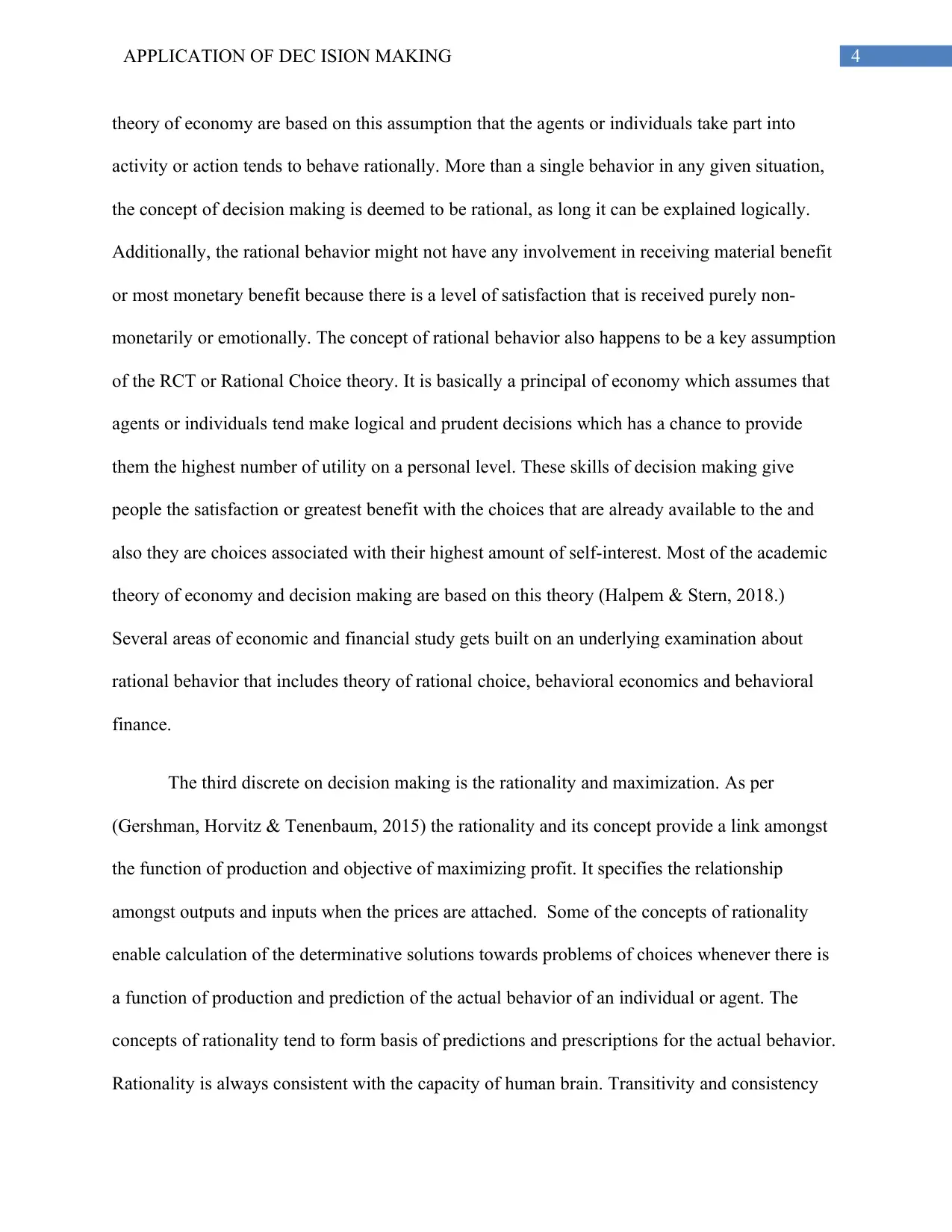
4APPLICATION OF DEC ISION MAKING
theory of economy are based on this assumption that the agents or individuals take part into
activity or action tends to behave rationally. More than a single behavior in any given situation,
the concept of decision making is deemed to be rational, as long it can be explained logically.
Additionally, the rational behavior might not have any involvement in receiving material benefit
or most monetary benefit because there is a level of satisfaction that is received purely non-
monetarily or emotionally. The concept of rational behavior also happens to be a key assumption
of the RCT or Rational Choice theory. It is basically a principal of economy which assumes that
agents or individuals tend make logical and prudent decisions which has a chance to provide
them the highest number of utility on a personal level. These skills of decision making give
people the satisfaction or greatest benefit with the choices that are already available to the and
also they are choices associated with their highest amount of self-interest. Most of the academic
theory of economy and decision making are based on this theory (Halpem & Stern, 2018.)
Several areas of economic and financial study gets built on an underlying examination about
rational behavior that includes theory of rational choice, behavioral economics and behavioral
finance.
The third discrete on decision making is the rationality and maximization. As per
(Gershman, Horvitz & Tenenbaum, 2015) the rationality and its concept provide a link amongst
the function of production and objective of maximizing profit. It specifies the relationship
amongst outputs and inputs when the prices are attached. Some of the concepts of rationality
enable calculation of the determinative solutions towards problems of choices whenever there is
a function of production and prediction of the actual behavior of an individual or agent. The
concepts of rationality tend to form basis of predictions and prescriptions for the actual behavior.
Rationality is always consistent with the capacity of human brain. Transitivity and consistency
theory of economy are based on this assumption that the agents or individuals take part into
activity or action tends to behave rationally. More than a single behavior in any given situation,
the concept of decision making is deemed to be rational, as long it can be explained logically.
Additionally, the rational behavior might not have any involvement in receiving material benefit
or most monetary benefit because there is a level of satisfaction that is received purely non-
monetarily or emotionally. The concept of rational behavior also happens to be a key assumption
of the RCT or Rational Choice theory. It is basically a principal of economy which assumes that
agents or individuals tend make logical and prudent decisions which has a chance to provide
them the highest number of utility on a personal level. These skills of decision making give
people the satisfaction or greatest benefit with the choices that are already available to the and
also they are choices associated with their highest amount of self-interest. Most of the academic
theory of economy and decision making are based on this theory (Halpem & Stern, 2018.)
Several areas of economic and financial study gets built on an underlying examination about
rational behavior that includes theory of rational choice, behavioral economics and behavioral
finance.
The third discrete on decision making is the rationality and maximization. As per
(Gershman, Horvitz & Tenenbaum, 2015) the rationality and its concept provide a link amongst
the function of production and objective of maximizing profit. It specifies the relationship
amongst outputs and inputs when the prices are attached. Some of the concepts of rationality
enable calculation of the determinative solutions towards problems of choices whenever there is
a function of production and prediction of the actual behavior of an individual or agent. The
concepts of rationality tend to form basis of predictions and prescriptions for the actual behavior.
Rationality is always consistent with the capacity of human brain. Transitivity and consistency
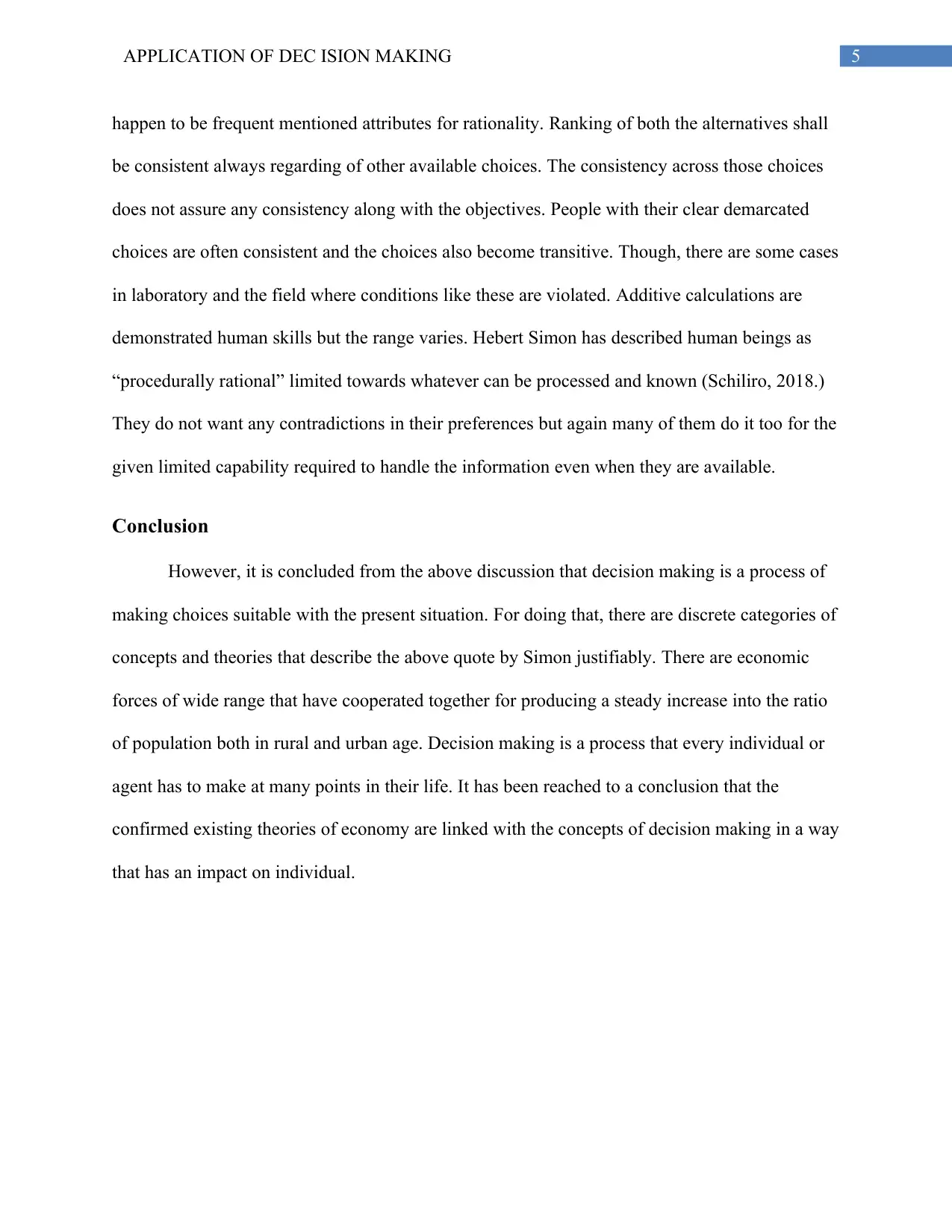
5APPLICATION OF DEC ISION MAKING
happen to be frequent mentioned attributes for rationality. Ranking of both the alternatives shall
be consistent always regarding of other available choices. The consistency across those choices
does not assure any consistency along with the objectives. People with their clear demarcated
choices are often consistent and the choices also become transitive. Though, there are some cases
in laboratory and the field where conditions like these are violated. Additive calculations are
demonstrated human skills but the range varies. Hebert Simon has described human beings as
“procedurally rational” limited towards whatever can be processed and known (Schiliro, 2018.)
They do not want any contradictions in their preferences but again many of them do it too for the
given limited capability required to handle the information even when they are available.
Conclusion
However, it is concluded from the above discussion that decision making is a process of
making choices suitable with the present situation. For doing that, there are discrete categories of
concepts and theories that describe the above quote by Simon justifiably. There are economic
forces of wide range that have cooperated together for producing a steady increase into the ratio
of population both in rural and urban age. Decision making is a process that every individual or
agent has to make at many points in their life. It has been reached to a conclusion that the
confirmed existing theories of economy are linked with the concepts of decision making in a way
that has an impact on individual.
happen to be frequent mentioned attributes for rationality. Ranking of both the alternatives shall
be consistent always regarding of other available choices. The consistency across those choices
does not assure any consistency along with the objectives. People with their clear demarcated
choices are often consistent and the choices also become transitive. Though, there are some cases
in laboratory and the field where conditions like these are violated. Additive calculations are
demonstrated human skills but the range varies. Hebert Simon has described human beings as
“procedurally rational” limited towards whatever can be processed and known (Schiliro, 2018.)
They do not want any contradictions in their preferences but again many of them do it too for the
given limited capability required to handle the information even when they are available.
Conclusion
However, it is concluded from the above discussion that decision making is a process of
making choices suitable with the present situation. For doing that, there are discrete categories of
concepts and theories that describe the above quote by Simon justifiably. There are economic
forces of wide range that have cooperated together for producing a steady increase into the ratio
of population both in rural and urban age. Decision making is a process that every individual or
agent has to make at many points in their life. It has been reached to a conclusion that the
confirmed existing theories of economy are linked with the concepts of decision making in a way
that has an impact on individual.
⊘ This is a preview!⊘
Do you want full access?
Subscribe today to unlock all pages.

Trusted by 1+ million students worldwide
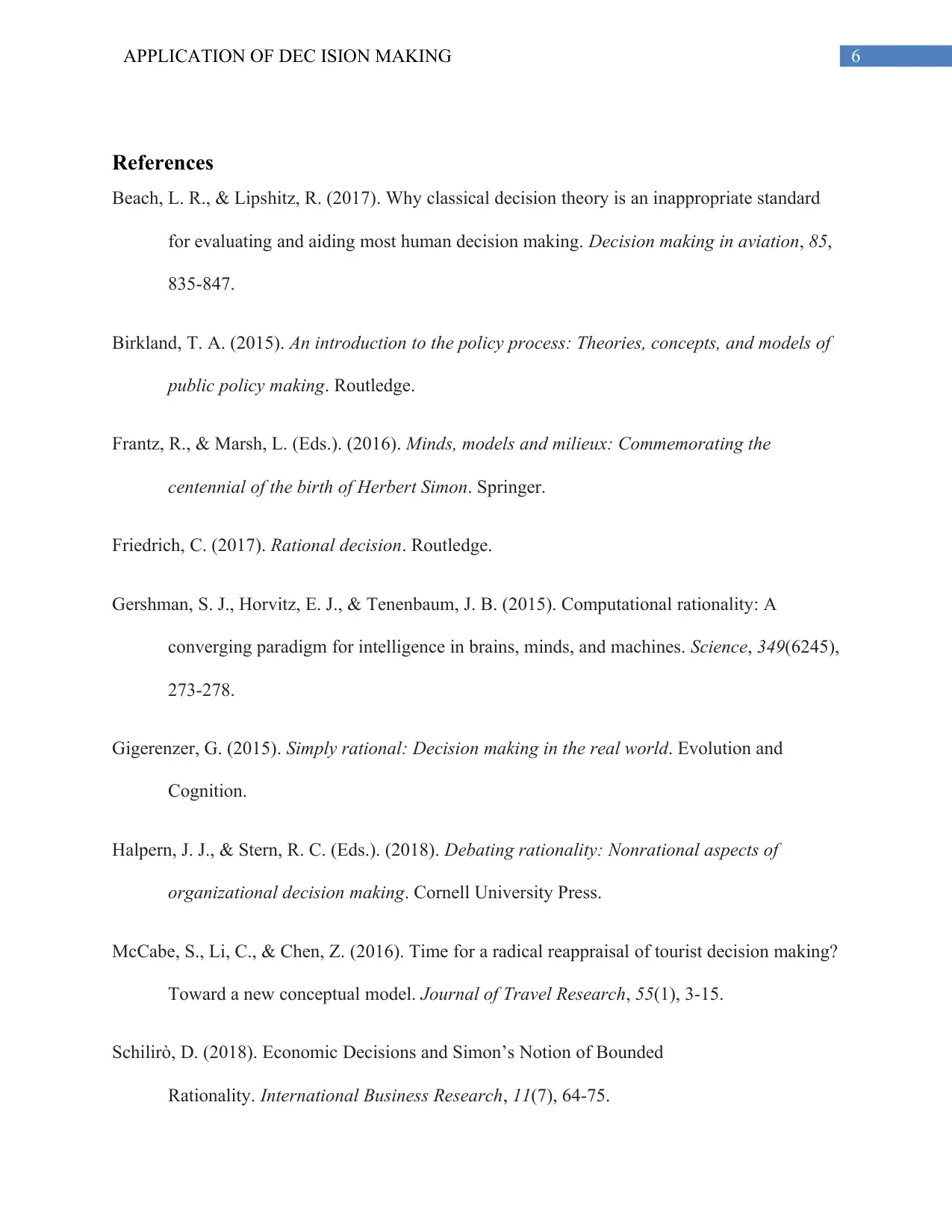
6APPLICATION OF DEC ISION MAKING
References
Beach, L. R., & Lipshitz, R. (2017). Why classical decision theory is an inappropriate standard
for evaluating and aiding most human decision making. Decision making in aviation, 85,
835-847.
Birkland, T. A. (2015). An introduction to the policy process: Theories, concepts, and models of
public policy making. Routledge.
Frantz, R., & Marsh, L. (Eds.). (2016). Minds, models and milieux: Commemorating the
centennial of the birth of Herbert Simon. Springer.
Friedrich, C. (2017). Rational decision. Routledge.
Gershman, S. J., Horvitz, E. J., & Tenenbaum, J. B. (2015). Computational rationality: A
converging paradigm for intelligence in brains, minds, and machines. Science, 349(6245),
273-278.
Gigerenzer, G. (2015). Simply rational: Decision making in the real world. Evolution and
Cognition.
Halpern, J. J., & Stern, R. C. (Eds.). (2018). Debating rationality: Nonrational aspects of
organizational decision making. Cornell University Press.
McCabe, S., Li, C., & Chen, Z. (2016). Time for a radical reappraisal of tourist decision making?
Toward a new conceptual model. Journal of Travel Research, 55(1), 3-15.
Schilirò, D. (2018). Economic Decisions and Simon’s Notion of Bounded
Rationality. International Business Research, 11(7), 64-75.
References
Beach, L. R., & Lipshitz, R. (2017). Why classical decision theory is an inappropriate standard
for evaluating and aiding most human decision making. Decision making in aviation, 85,
835-847.
Birkland, T. A. (2015). An introduction to the policy process: Theories, concepts, and models of
public policy making. Routledge.
Frantz, R., & Marsh, L. (Eds.). (2016). Minds, models and milieux: Commemorating the
centennial of the birth of Herbert Simon. Springer.
Friedrich, C. (2017). Rational decision. Routledge.
Gershman, S. J., Horvitz, E. J., & Tenenbaum, J. B. (2015). Computational rationality: A
converging paradigm for intelligence in brains, minds, and machines. Science, 349(6245),
273-278.
Gigerenzer, G. (2015). Simply rational: Decision making in the real world. Evolution and
Cognition.
Halpern, J. J., & Stern, R. C. (Eds.). (2018). Debating rationality: Nonrational aspects of
organizational decision making. Cornell University Press.
McCabe, S., Li, C., & Chen, Z. (2016). Time for a radical reappraisal of tourist decision making?
Toward a new conceptual model. Journal of Travel Research, 55(1), 3-15.
Schilirò, D. (2018). Economic Decisions and Simon’s Notion of Bounded
Rationality. International Business Research, 11(7), 64-75.
Paraphrase This Document
Need a fresh take? Get an instant paraphrase of this document with our AI Paraphraser
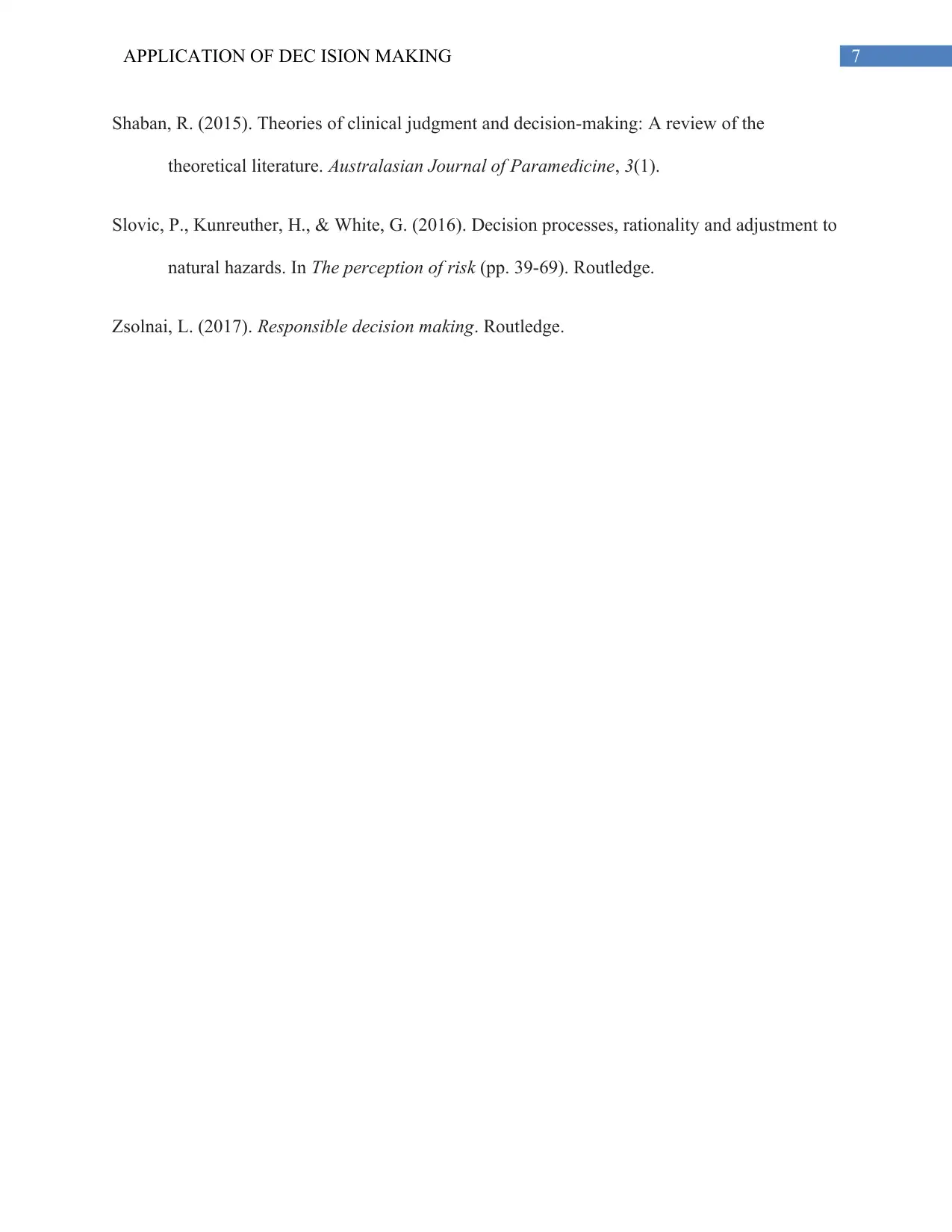
7APPLICATION OF DEC ISION MAKING
Shaban, R. (2015). Theories of clinical judgment and decision-making: A review of the
theoretical literature. Australasian Journal of Paramedicine, 3(1).
Slovic, P., Kunreuther, H., & White, G. (2016). Decision processes, rationality and adjustment to
natural hazards. In The perception of risk (pp. 39-69). Routledge.
Zsolnai, L. (2017). Responsible decision making. Routledge.
Shaban, R. (2015). Theories of clinical judgment and decision-making: A review of the
theoretical literature. Australasian Journal of Paramedicine, 3(1).
Slovic, P., Kunreuther, H., & White, G. (2016). Decision processes, rationality and adjustment to
natural hazards. In The perception of risk (pp. 39-69). Routledge.
Zsolnai, L. (2017). Responsible decision making. Routledge.
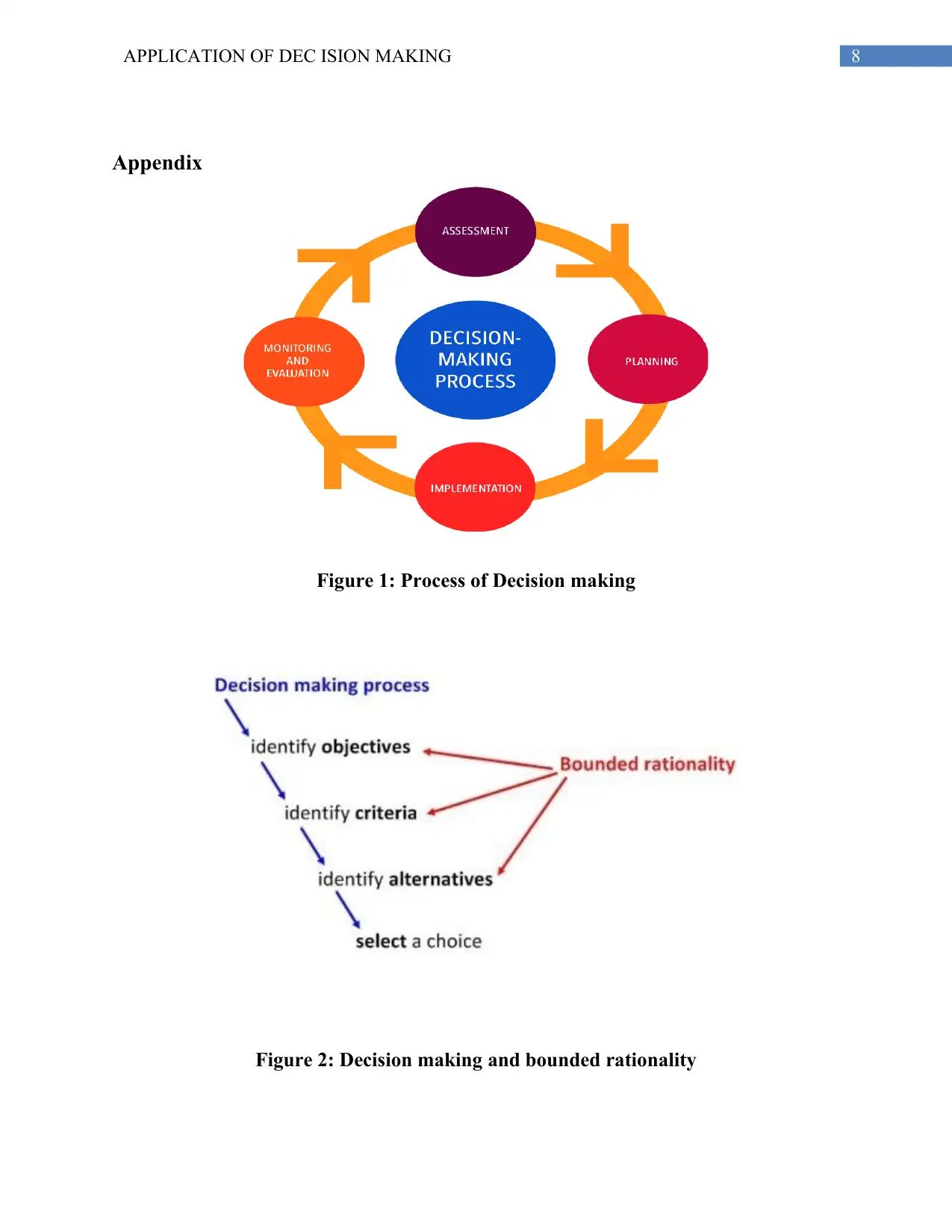
8APPLICATION OF DEC ISION MAKING
Appendix
Figure 1: Process of Decision making
Figure 2: Decision making and bounded rationality
Appendix
Figure 1: Process of Decision making
Figure 2: Decision making and bounded rationality
⊘ This is a preview!⊘
Do you want full access?
Subscribe today to unlock all pages.

Trusted by 1+ million students worldwide
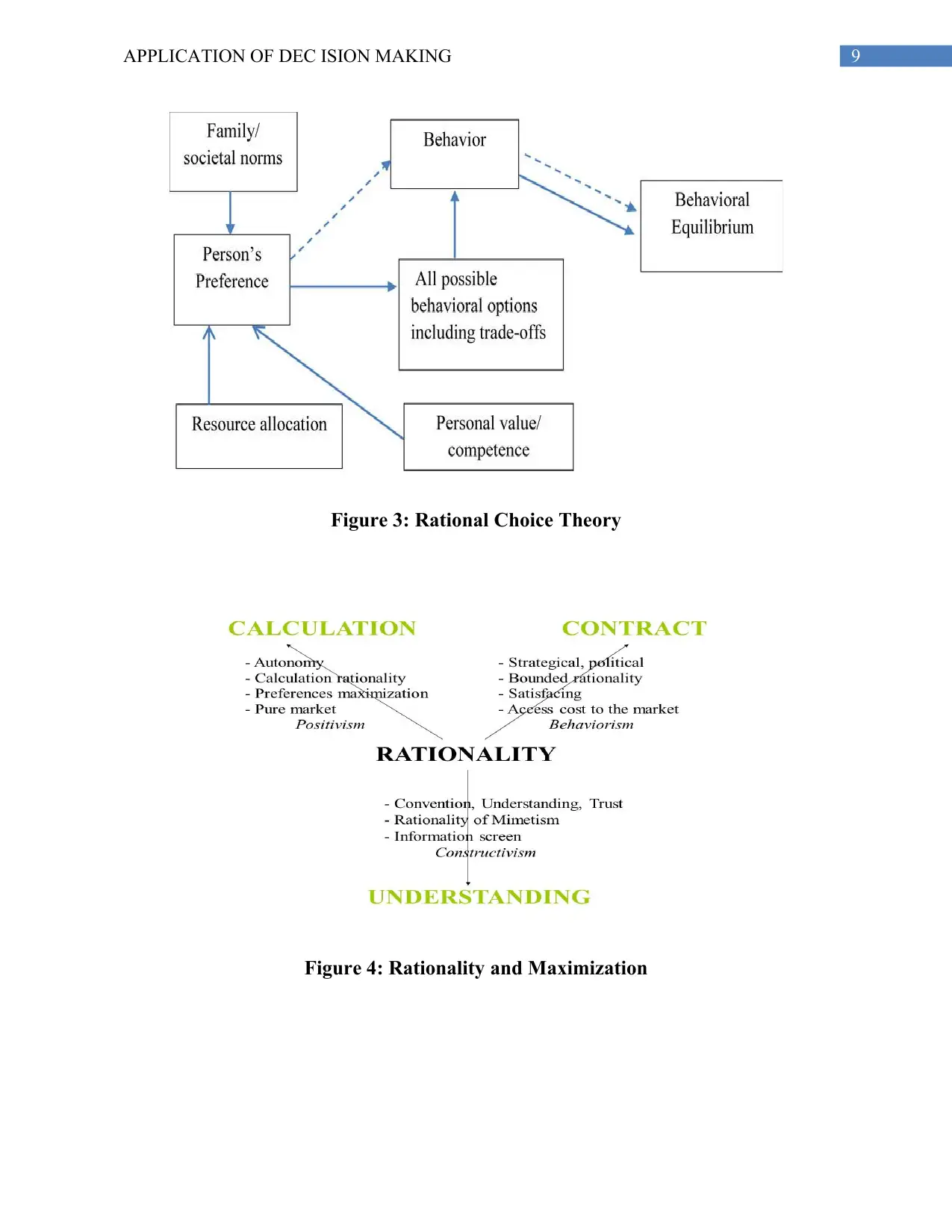
9APPLICATION OF DEC ISION MAKING
Figure 3: Rational Choice Theory
Figure 4: Rationality and Maximization
Figure 3: Rational Choice Theory
Figure 4: Rationality and Maximization
1 out of 10
Related Documents
Your All-in-One AI-Powered Toolkit for Academic Success.
+13062052269
info@desklib.com
Available 24*7 on WhatsApp / Email
![[object Object]](/_next/static/media/star-bottom.7253800d.svg)
Unlock your academic potential
Copyright © 2020–2025 A2Z Services. All Rights Reserved. Developed and managed by ZUCOL.





